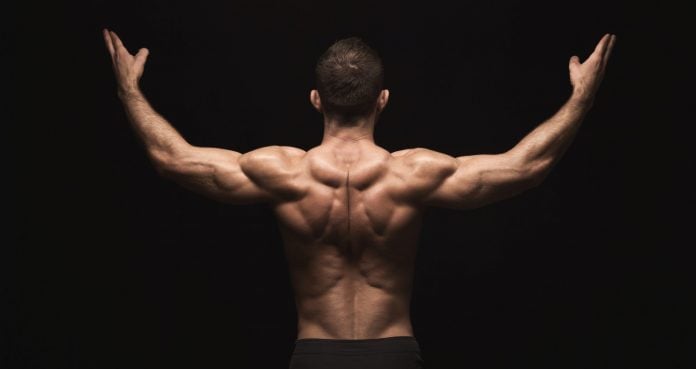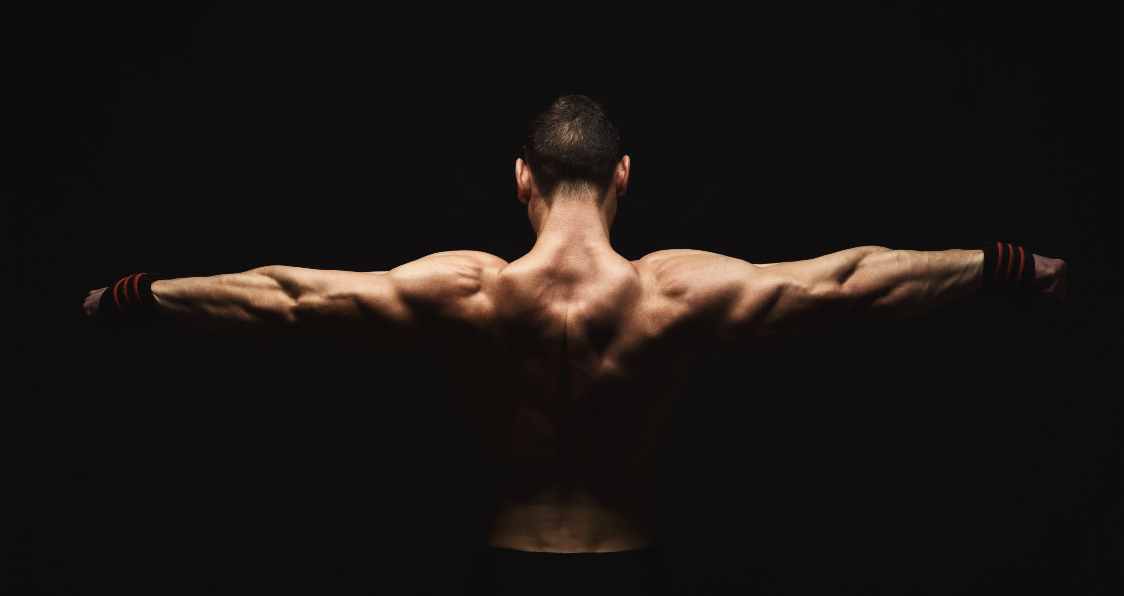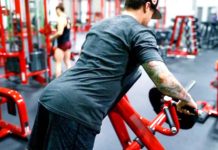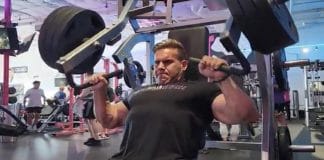
Develop Back Strength and Size With The Pendlay Row and The Barbell Row Exercises
For working the muscles of the back, there is no exercise that compares to the row. There are a number of variations that can be used to develop the lats, rhomboids, and traps.
Two commonly used rowing variations are the pendlay row and the conventional barbell row.
Although similar in movement and muscle activation, there are small differences between the two that change the dynamic of the exercise.
This article will explain how to perform both the pendlay and conventional barbell row and will detail the three of the biggest benefits associated with both rowing variations.
The Pendlay Row
Glenn Pendlay is the strength and conditioning coach who is attributed with creating the pendlay row.
Pendlay believes that this variation of the row is how the row should be performed and will lead to optimal back development.
The pendlay row involves starting with the bar on the floor, pulling it tight to the body before returning it to the floor.
Because the bar starts from the floor, it requires you to significantly hinge the hips so that the back is approximately parallel with the floor.
Glenn Pendlay was a huge advocate of this variation as returning the bar to the floor with each rep requires strict form and negates the use of momentum that is sometimes seen in other rowing exercises.
Be aware that because of the trunk position, it may be necessary to use a lighter weight than you normally would with a conventional barbell row. To perform the pendlay row, use the following five steps:
Step One: Start by placing a loaded barbell directly in front of you on the floor. Place your feet directly under the bar at approximately hip-width.
Step Two: To assume the correct position, focus on driving the hips back while keeping the knees slightly bent so that the trunk of the body tips forwards and the back stays flat.
Reach down and grip the bar using an overhand grip with the hands slightly wider than shoulder-width apart.
Step Three: Before lifting the weight from the floor, pull your shoulders back and down and squeeze your core muscles.
Step Four: Powerfully lift the weight from the floor by squeezing the shoulder blades together and hinging the elbows. Pull the bar into the abdomen keeping the elbows as tight to the body as possible.
Step Five: Lower the bar back to the floor by extending at the elbows. Keep the core braced throughout to stabilize the movement and prevent the back from moving or rounding.
The Barbell Row
The barbell row may refer to a range of barbell rowing exercises – for example, wide grip, narrow grip, underhand, and overhand row.
The biggest difference between the pendlay row and the conventional bent barbell row is the back angle.
As the pendlay row takes place from the floor, the back is parallel to the floor. With the bent row, the angle may vary – however, typically, the back angle is typically 45-degrees.
Unlike the pendlay row where the bar returns to the floor with each rep, with the conventional row, the bar is suspended just in front, in-line or above the knees depending on the back angle.
To perform the conventional barbell row, work through the following steps:
Step One: Start with the feet under the hips, grip the bar with an overhand grip that is slightly wider than shoulder-width. Pick the bar up and stand up tall with the bar in hand.
Step Two: Push the chest high, pull the shoulders back and down, and engage the core muscles.
Step Three: While keeping the knees soft, drive the hips back so that the trunk begins to tip forward. Keep the bar tight to the legs and continue pushing the hips back until the back is at a 45-degree angle.
Step Four: Pull the shoulder blades together and hinge the elbows to bring the bar into the trunk while preventing the elbows from excessively flaring out.
Step Five: Maintain a core brace and lower the bar in a controlled fashion back to the starting position.
The Benefits of Both Rowing Exercises
This section will highlight the benefits of regularly performing these two rowing variations.
Because the movements are similar there are some benefits that apply to both the pendlay and barbell row. However, the slight variation between the two exercises does means that there are also some unique benefits.
1) Building Muscle Size
For those who wish to improve their aesthetics or performance, it may be necessary to increase muscle size.
Rows have the potential to build a significant amount of muscle. This is because rows are compound movements that recruit many muscles across a number of joints.
Compound exercises have been shown to be highly effective for building muscle size. This is primarily because a relatively large amount of weight can be lifted with compound exercises.
Lifting heavy weight will apply mechanical tension, increase metabolic stress, and cause a substantial amount of muscle damage – these three are all critical components of muscle growth (1).
Rowing exercises have been found to activate the latissimus dorsi, rhomboids, traps, and biceps (2). Therefore, regularly performing these exercises can lead to muscle growth in these areas.
Studies have suggested that targetting muscles from multiple angles may enhance the rate of muscle growth (3).
Consequently, it may be beneficial to incorporate a number of rowing variations, such as the pendlay row, in order to hit the back muscles from different angles to maximize muscle growth.
2) Strength Development
In a similar vein to muscle growth, heavy compound exercises are excellent for increasing strength capacity (4).
Therefore, the barbell row and its variations can be considered effective for strength development.
If you are unsure which variation would be best for optimizing strength, consider your goals, needs, and limitations.
If you are having issues with positional strength, it may be an idea to use the pendlay row as this places a greater demand on mobility and static strength.
For example, many individuals find that they cannot keep the back flat during the deadlift. Therefore, by incorporating the pendlay row into their training, they can develop this ability.
However, if your goal is to maximally build muscular strength, focus on heavy barbell rows.
While a substantial amount of weight can still be lifted with the pendlay row, the barbell row will typically allow you to lift a heavier amount of weight and may, therefore, be superior for gaining strength.
3) Specific to Powerlifting and Weightlifting
It is clear that both rowing variations are highly beneficial for building general strength and size.
Some may argue that barbell rows are superior to the pendlay row in terms of raw strength development, however, there are specific strength benefits associated with the pendlay row.
For any lifter who struggles with back, core, and hamstring strength, it may be wise to select the pendlay row over the conventional barbell row.
For powerlifters and weightlifters, the pendlay row may also serve a greater purpose than the barbell row.
As mentioned, the pendlay row is particularly useful for developing static as well as concentric strength.
Therefore, for weightlifters, developing strength in this fashion can help to enhance snatch and clean performance while also allowing you to move beyond any sticking points.
For powerlifters, enhancing full-body static and concentric strength can facilitate a better squat and deadlift performance.
Therefore, although it is likely that a heavier weight can be lifted during the barbell row, the weight on the bar is not always the most important factor worth considering.
Row Programming Considerations
The row has significant potential to build muscle strength and size and, therefore, some form of rowing variation should be included in your training program.
However, be aware that the training volume that you use will have a substantial impact on the rate of development.
For maximizing strength improvements, heavy weight should be prioritized. It is recommended to exceed no more than five reps per set.
Although the traditional understanding dictates that six to twelve reps is best for maximizing hypertrophy, more recent research has shown that hypertrophy occurs throughout a range of reps (5).
Therefore, if your goal is to improve muscular size, your focus must be on increasing total training volume.
Final Word
While there are minor differences between the setup of the pendlay and conventional barbell row, the movement patterns are relatively similar and therefore, both can significantly build full-body strength and size.
Let us know what you think in the comments below. Also, be sure to follow Generation Iron on Facebook, Twitter, and Instagram.
*Images courtesy of Envato
References:
1 – Schoenfeld, Brad J. (2010-10). “The mechanisms of muscle hypertrophy and their application to resistance training”. Journal of Strength and Conditioning Research. 24 (10): 2857–2872. doi:10.1519/JSC.0b013e3181e840f3. ISSN 1533-4287. PMID 20847704.
2 – Lehman, Gregory J; Buchan, Day Deans; Lundy, Angela; Myers, Nicole; Nalborczyk, Andrea (June 30, 2004). “Variations in muscle activation levels during traditional latissimus dorsi weight training exercises: An experimental study”. Dynamic medicine : DM. 3: 4. doi:10.1186/1476-5918-3-4. ISSN 1476-5918. PMID 15228624.
3 – Barakat, Christopher; Barroso, Renato; Alvarez, Michael; Rauch, Jacob; Miller, Nicholas; Bou-Sliman, Anton; De Souza, Eduardo O. (September 4, 2019). “The Effects of Varying Glenohumeral Joint Angle on Acute Volume Load, Muscle Activation, Swelling, and Echo-Intensity on the Biceps Brachii in Resistance-Trained Individuals”. Sports (Basel, Switzerland). 7 (9). doi:10.3390/sports7090204. ISSN 2075-4663. PMC 6783981. PMID 31487841.
4 – Paoli, Antonio; Gentil, Paulo; Moro, Tatiana; Marcolin, Giuseppe; Bianco, Antonino (December 22, 2017). “Resistance Training with Single vs. Multi-joint Exercises at Equal Total Load Volume: Effects on Body Composition, Cardiorespiratory Fitness, and Muscle Strength”. Frontiers in Physiology. 8. doi:10.3389/fphys.2017.01105. ISSN 1664-042X. PMC 5744434. PMID 29312007.
5 – Schoenfeld, Brad J.; Grgic, Jozo; Ogborn, Dan; Krieger, James W. (2017-12). “Strength and Hypertrophy Adaptations Between Low- vs. High-Load Resistance Training: A Systematic Review and Meta-analysis”. Journal of Strength and Conditioning Research. 31 (12): 3508–3523. doi:10.1519/JSC.0000000000002200. ISSN 1533-4287. PMID 28834797


















